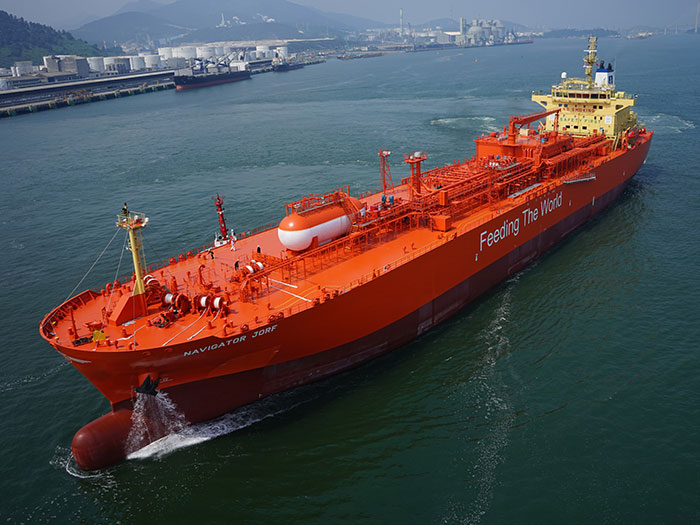
DNV: “No show stoppers” for ammonia-fueled gas carrier design
Written by Nick Blenkey
Navigator Gas, the owner and operator of the world’s largest fleet of handysize liquefied gas carriers, has received a new AiP from DNV for an ammonia fueled gas carrier. [Image: Navigator Gas]
DNV has awarded Navigator Gas an Approval in Principle (AiP) for an ammonia-fueled gas carrier design developed by industrywide consortium, including MAN Energy Solutions, Babcock International, and the Norwegian Maritime Authority (NMA).
The AiP has been awarded based on the special features notation (GF NH3) under DNV’s new rules for the use of ammonia as fuel in gas carriers. DNV, says it reviewed the design and relevant documentation alongside NMA and “found no potential show-stoppers to its realization.”
“Navigator Gas been discussing ammonia as a fuel with our consortium partners since 2018, when this topic was on the fringes of discussions surrounding decarbonization and the use of alternative fuels,” said Paul Flaherty, Technical advisor to Navigator Gas. “Those early discussions on feasibility led to the completion of a comprehensive HAZID in early 2019, which remains as valid today as it was then. This has also been used as the base safety case during our AiP discussions with DNV. Since our discussions began, we have witnessed an exponential increase in the number of projects around the globe looking at hydrogen and ammonia as carbon-free sources of energy. We have also been engaging with our customers and business partners to discuss their carbon free shipping requirements for transporting blue/green ammonia to their customers.”
FIRST STEP
“Obtaining an AiP from DNV for an ammonia-fueled vessels is the first step in preparing Navigator Gas to meet the future demands of our customers and to reduce our carbon footprint through lower greenhouse gas emissions.” Flaherty continued. “In the longer term, using ammonia as fuel is one of alternative fuels options we are pursuing, along with CCS [carbon capture and storage], carbon offsetting and improved vessel optimization to reduce our carbon footprint and lower greenhouse gas emissions. I would like to thank DNV, MAN Energy Solutions, Babcock International and the Norwegian Maritime Authority, for their unwavering support and input during the AiP process.” said Paul Flaherty.
“We are very pleased to be working with Navigator Gas and so many leading companies on this AiP,” said Torgeir Sterri, senior vice president, regional manager West Europe, DNV Maritime. “If our industry is going to continue to play a central role in the global economy, we need to be exploring all options that can get us further towards decarbonization. At the same time, we recognize that for our customers, how to tackle the decarbonization challenge is going to be most challenging and significant decision they are likely to make this decade. This is why we have created class notations and guideline that give them the flexibility to find the path that fits their operations and business.”
“This ammonia as a fuel concept design is supported by Babcock LGE’s operational experience of delivering liquefied petroleum gas (LPG) fuel supply systems and carrying ammonia as a cargo on gas carriers, meaning specific issues occurring when utilizing ammonia as a fuel are well understood, resulting in an inherently safe design,” said Andrew Scott, Babcock LGE’s business development director. “Babcock LGE is enabling the transition towards a cleaner, sustainable future through innovative technologies, and we are delighted to be working with our partners in this significant project.
”
“MAN Energy Solutions is pleased to work with industry partners in decarbonizing the maritime economy where, for us, the path starts with fuel decarbonization. Here, several zero-carbon fuels offer significant potential, with ammonia of especial interest,” said Thomas S. Hansen, head of promotion and customer support, MAN Energy Solutions. “Since large quantities of ammonia are already transported around the world, it is a well-established commodity and using it to power ships would be a natural step. In this context, we have already announced that we expect to be make a dual-fuel, two-stroke ammonia engine commercially available for large-scale ocean-going ships by 2024, followed by a retrofit package to make existing maritime vessels capable of running on ammonia by 2025.”
“We are proud to be a part of this project and it has given us vital input on how to handle the safety concerns when using ammonia as fuel. Ammonia could play an important role in the decarbonization of shipping and therefore the safety concerns have to be addressed. This project shows that it’s possible to manage some of the challenges within de




